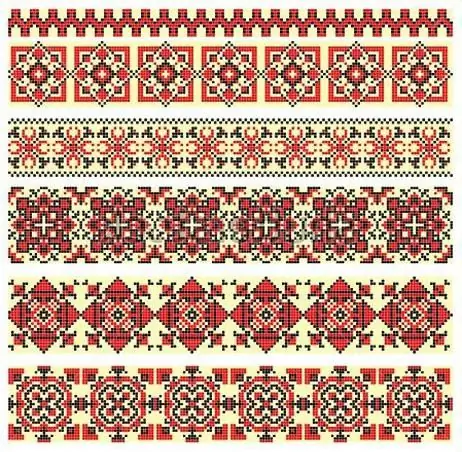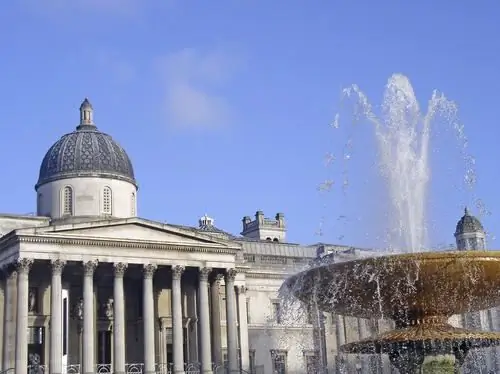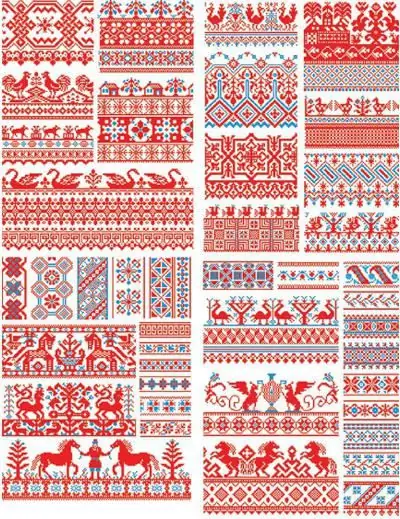2026 Author: Leah Sherlock | [email protected]. Last modified: 2025-01-24 17:46:35
To understand what a Kazakh pattern is and what a Kazakh ornament is, it is necessary to clarify what a pattern and ornament are in general and how they differ from each other. A pattern is a specific pattern that is created by a combination of colors and lines. The ornament is the same pattern or its elements repeating in a certain order. That is, these two concepts are very intertwined and interconnected.

An integral element of arts and crafts
Each nation has its own original culture, the elements of which are patterns and ornaments. Among them there are very rare ones that came from ancient times; these masterpieces of decorative and applied art are kept in ethnographic museums.
Kazakh pattern is unique like any other. Despite the fact that the term “ornament” is translated from Latin as decoration, scientists come to the conclusion that some information is stored in each national pattern. No wonder quite often the ornament is associated withthe birth of writing.
Magic Writings
Associated with magic. Ethnographers suggest that the ancient peoples' idea of the surrounding reality and the structure of the world is embedded in the ornaments. Each nation has its own ornamental style, and the Kazakh pattern can be easily distinguished from the drawings of other ethnic groups. The way of life of the people is reflected in the national applied art. The Kazakhs have their roots in ancient pastoral tribes, the ancestors of this people were the Turks and Huns, Saks and Kangly, Kipchaks and Usuns. The ancients believed that the drawn symbols served as amulets, and drew what they thought could save and help in everyday life.
The main group of motifs of Kazakh patterns
It is not surprising that zoomorphic motifs predominate in the Kazakh ornament. In the animal ornament, images of real and fantastic animals are repeated in whole or in fragments. The Kazakh pattern contains images of domestic animals - a horse, a camel or a ram - and steppe, wild ones - an eagle, a wolf, a falcon.

Very often the ornament consists of separate parts of animals - heads, hooves, ears and so on. There are specific names for such patterns - "bugu muyiz" or "koshkar muyiz" ("deer horn" or "ram's horn", respectively), "at bas" is translated as "horse's head". But not only animal motifs exist in the folk arts and crafts of Kazakhstan, although this is the most extensive group of motifs.
Another one of the four is cosmogonic

National ornaments are conditionally divided into cosmogonic, already mentioned above zoomorphic, floral and geometric. The patterns of many peoples contain these motifs. From the name "cosmogonic" it is easy to imagine that the ornament contains the image of some luminary. In the Kazakh version, it is a crescent, or aishik gul. "Au gul" ("moon flower") is an ancient ornament. Each element of this pattern can be a crescent of a certain size and direction. There are also solar motifs - "sunrise" ("shikkan kun"), "eye of the sun" ("kun kozi") and "rays of the sun" ("kun saulesi"). There are also star motifs, which are mainly used for embroidering outerwear - “zhuldyz gul”, “zhuldyz ornek”, “top zhuldyz” and the complex motif “segiz kyrly ornek”. It is a star enclosed in an octagonal rosette.
Vegetal and geometric motifs
Kazakh patterns and ornaments abound with plant motifs, although, as already noted, zoomorphic ones are dominant. Water, sacred to pastoralists, represented by a wavy line and called "su", serves to frame ornaments, or intervals. The symbol of the earth, which has found its reflection in the ornament "nine hills" ("togyz tobe") is the most ancient and is found on the artifacts of the Huns and Sarmatians. Geometric Kazakh patterns and ornaments are characterized by a variety of all kinds of lines - wavy and spiral, straight lines of different thicknesses and cords, there are also chains of various shapes. characteristic of Kazakhgeometric patterns is the proportional division of figures and the observance of a clear balance between the individual elements. It should be noted that in almost every group of ornaments there are basic motifs and derivatives. The oldest motif of a geometric group is an image resembling a comma - "alshi". The motif called "alshim bar" serves as a symbol of good luck, prosperity, happiness.
Peculiar and wonderful

Kazakh national patterns are often justly called writings from the past, because even household items are displayed in them, from them, like from a book, you can learn information about the life of distant ancestors. The most common of this group of ornaments in antiquity was the “heel” and “broken heel” (“okshe gul” and “synar okshe”, respectively). In a short article, it is impossible even to list the names of motifs of ornaments, and even to indicate their meaning and indicate for what and where this or that pattern was used. It can be noted that they are unusually beautiful, the clothes decorated with them are magnificent. A striking example is the uniform of the Kazakh Olympians and those accompanying the team at the Olympic Games in Sochi. Looking at the patterns, motifs, ornaments, you plunge into an amazing, original, bright fairy-tale world. But, as the proverb advises, "it is better to see once." Above are just a few of the gigantic number of Kazakh patterns.
Recommended:
How to make a simple and beautiful pattern - geometric ornament

Need to make a beautiful pattern? Geometric ornament is the easiest option. Do you want to know how to draw it? Read the article
Kazakh poets. Kazakh poetry

Like free hawks, daring kulans (stallions), Kazakh "masters of words and songs" carried the truth, to lead in verse from one end of the endless steppe to the other. For the Kazakh people, poetry was both a consolation in times of hardship, suffering, and a way to express any joy, happiness, to sing the courage of national heroes
Soviet television announcers are the property of national culture

Soviet television announcers became an integral part of the country's culture, a source of pride and respect. They not only communicated with the population, read the news and commented on festive events, but were also role models, icons of style and a model of professional attitude to business
National Gallery in London (National Gallery). National Gallery of London - paintings

This article tells about the history of the creation of the National Gallery of London, as well as about the works of which artists can be seen within the walls of this museum
Russian folk pattern. How to draw a Russian pattern

Russian folk pattern… How much mystery there is in it, how much everything is forgotten and ancient. Why is Russian embroidery so special with its unique pattern and ornament? Some information about this can be found in the article

